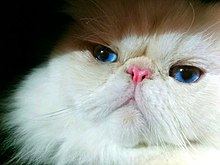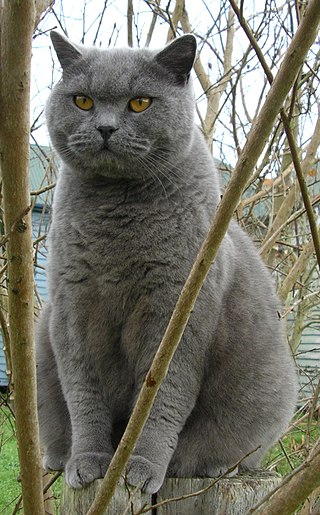
The British Shorthair is the pedigreed version of the traditional British domestic cat, with a distinctively stocky body, thick coat, and broad face. The most familiar colour variant is the "British Blue", with a solid grey-blue coat, pineapple eyes, and a medium-sized tail. The breed has also been developed in a wide range of other colours and patterns, including tabby and colourpoint.
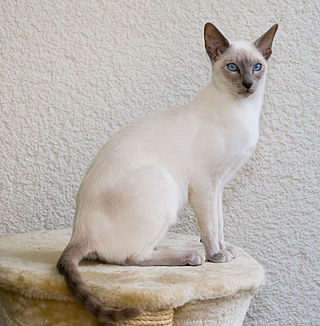
The Siamese cat is one of the first distinctly recognised breeds of Asian cat. Derived from the Wichianmat landrace, one of several varieties of cats native to Thailand, the original Siamese became one of the most popular breeds in Europe and North America in the 19th century. Siamese cats have a distinctive colourpoint coat, resulting from a temperature-sensitive type of albinism.

The Exotic Shorthair is a breed of cat developed as a short-haired version of the Persian. The Exotic is similar to the Persian in appearance with the exception of the short dense coat.

The Scottish Fold is a distinctive breed of domestic cat characterised by a natural dominant gene mutation associated with osteochondrodysplasia. This genetic anomaly affects cartilage throughout the body, causing the ears to "fold", bending forward and down towards the front of the head. While this trait contributes to the breed's unique appearance, often described as "owl-like", it has negative effects on the cats' welfare.

The Ocicat is an all-domestic breed of cat which resembles a wild cat but has no recent wild DNA in its gene pool. It is named for its resemblance to the ocelot. The breed was established from the Siamese and Abyssinian and later on American Shorthair would be added.

The Birman, also called the "Sacred Cat of Burma", is a domestic cat breed. The Birman is a long-haired, colour-pointed cat distinguished by a silky coat, deep blue eyes, and contrasting white "gloves" on each paw.

The Burmese cat is a breed of domestic cat, originating in Burma, believed to have its roots near the Thai-Burma border and developed in the United States and Britain.

The Egyptian Mau is a small to medium-sized short-haired cat breed. They are one of the few naturally spotted breeds of domesticated cat. The spots of the Mau occur on only the tips of the hairs of its coat. It is considered a rare breed.
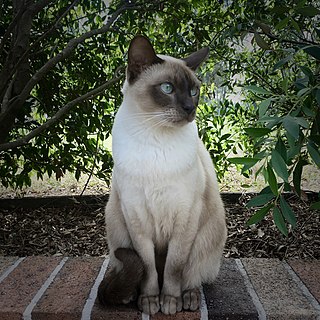
Tonkinese is a domestic cat breed produced by crossbreeding between the Siamese and Burmese. Members of the breed are distinguished by a pointed coat pattern in a variety of colors. In addition to the modified coat colors of the "mink" pattern, which is a dilution of the point color, the breed is now being shown in the foundation-like Siamese and Burmese colors: pointed with white and solid overall (sepia).

The Ragdoll is a breed of cat with a distinct colorpoint coat and blue eyes. Its morphology is large and weighty, and it has a semi-long and silky soft coat. American breeder Ann Baker developed Ragdolls in the 1960s. They are best known for their docile, placid temperament and affectionate nature. The name 'Ragdoll' is derived from the tendency of individuals from the original breeding stock to go limp and relaxed when picked up. The breed is particularly popular in both the United Kingdom and the United States.

The Javanese, also known as the ColorpointLonghair in some registries, is a variety of purebred domestic cat.

The Oriental Shorthair is a breed of domestic cat that is developed from and closely related to the Siamese cat. It maintains the modern Siamese head and body type but appears in a wide range of coat colors and patterns. Like the Siamese, Orientals have almond-shaped eyes, a triangular head shape, large ears, and an elongated, slender, and muscular body. Their personalities are also very similar. Orientals are social, intelligent, and many are rather vocal. They often remain playful into adulthood, with many enjoying playing fetch. Despite their slender appearance, they are athletic and can leap into high places. They prefer to live in pairs or groups and also seek human interaction. Unlike the breed's blue-eyed forebear, Orientals are usually green-eyed. The Oriental Longhair differs only with respect to coat length.

The Siberian is a centuries-old landrace of domestic cat in Russia, and recently developed as a formal breed with standards promulgated the world over since the late-1980s. Since 2006, the breed is recognised for registry and championship status with all major cat registries.

The Colorpoint Shorthair is a variety of Siamese cat. The only major registries to recognise them are the Cat Fanciers' Association (CFA) and the World Cat Federation (WCF). This breed was established from breeding American Shorthairs with the Siamese to produce different point colors, beyond the four standard Siamese colors.

The Neva Masquerade is a breed or sub-breed of long-haired domestic cat, which originates in Russia. It is the sister breed or colourpoint variant of the Siberian cat, a centuries-old Russian landrace. The colourpoint markings are the result of a colourpoint gene originally found in Siamese cats. The Neva Masquerade is believed to be derived from crossing the Siberian cat with Asian colourpoint cats, such as the Siamese or Thai, or possibly cats related to those, such as the colourpointed Persian cats. Some cat registries may classify the Neva Masquerade as a colourpoint variety or sub-breed of the Siberian cat, while others consider it to be a separate sister breed. Regardless of its classification, all Neva Masquerade cats are selectively bred and pedigreed today in all major cat fancier and breeder organisations under the Siberian (Forest) cat or Neva Masquerade. This means that all Neva Masquerade cats are purebred cats with a formally registered ancestry.

The Ragamuffin is a breed of domestic cat. It was once considered to be a variant of the Ragdoll cat but was established as a separate breed in 1994. Ragamuffins are notable for their friendly personalities and thick fur.
A cat registry or cat breed registry, also known as a cat fancier organization, cattery federation, or cat breeders' association, is an organization that registers domestic cats of many breeds, for exhibition and for breeding lineage tracking purposes. A cat registry stores the pedigrees (genealogies) of cats, cattery names, and other details of cats; studbooks, breed descriptions, and the formal breed standards ; lists of judges qualified to judge at shows run by or affiliated with that registry, and sometimes other information. A cat registry is not the same as a breed club or breed society. Cat registries each have their own rules and usually also organize or license (sanction) cat shows. The show procedures vary widely, and awards won in one registry are not normally recognized by another. Some registries only serve breeders, while others are oriented toward pet owners and provide individual as well as cattery memberships, while yet others are federations only deal with breed clubs or even other registries as intermediaries between the organization and breeders.

The Minuet is a hybrid mix of Persian and Munchkin cat breeds. Categorized by The International Cat Association (TICA) as a domestic hybrid, "developed from a deliberate cross between two existing domestic breeds, incorporating characteristics of both parental breeds into the new mix." The Minuet cat is characterized by its short legs, as a result of the dwarfism-mutation derived from the Munchkin breed.
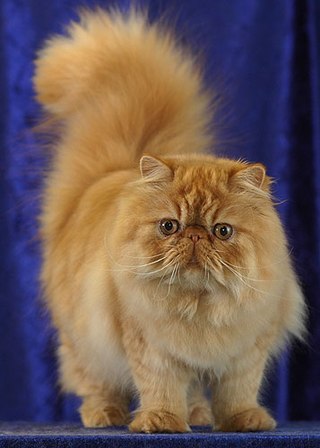
The Persian cat, also known as the Persian Longhair, is a long-haired breed of cat characterised by a round face and short muzzle. The first documented ancestors of Persian cats might have been imported into Italy from Khorasan as early as around 1620, however, this has not been proven. Instead, there is stronger evidence for a longhaired cat breed being exported from Afghanistan and Iran from the 19th century onwards. Widely recognised by the North-West European cat fancy since the 19th century, and after World War II by breeders from North America, Australia and New Zealand. Some cat fancier organisations' breed standards subsume the Himalayan and Exotic Shorthair as variants of this breed, while others generally treat them as separate breeds.
